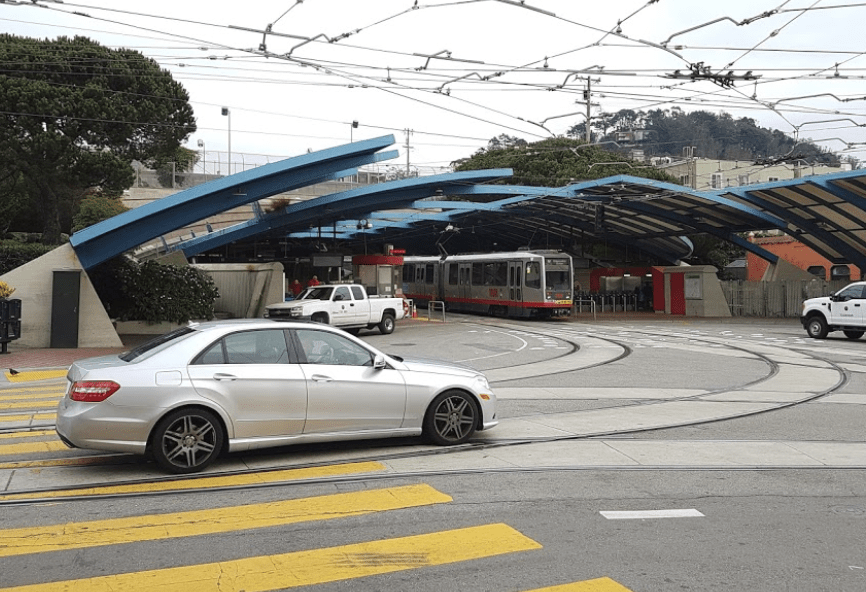Note: GJEL Accident Attorneys regularly sponsors coverage on Streetsblog San Francisco and Streetsblog California. Unless noted in the story, GJEL Accident Attorneys is not consulted for the content or editorial direction of the sponsored content.
At West Portal, the western end of Muni's Twin Peaks Tunnel, trains stop and start, sometimes waiting for several minutes for an opening in vehicle traffic. Muni's acting director Julie Kirschbaum is trying to improve the situation by having staff direct and hold traffic, easing trains into and out of the tunnel.
In addition, she is putting all of the system's bottlenecks under a "...microscope in effort to curb bus, rail delays" as reported in today's S.F. Chronicle.
From the article, by Rachel Swan:
In the next three months, acting transit director Julie Kirschbaum says she’ll cut stalls and interruptions by 10 percent in the subway and reduce the number of major stoppages — in which commuters are stranded for 20 minutes or longer — to four a month.
But as Streetsblog has pointed out before, Muni's biggest problem isn't the subway tunnel itself or any single bottleneck--it's the practice of making trains wait behind automobiles as soon as they leave it.
"Bringing in staff to direct traffic is a great start with immediate benefits," wrote the San Francisco Transit Riders's Rachel Hyden in an email to Streetsblog. She reports that staff seems to be giving trains priority over cars, at least during rush hour. But "...we would love to see permanent infrastructure implemented at West Portal that would give the trains priority to run without delay."
That means when trains leave and enter West Portal, they should be on red-carpet, transit-only lanes, and any automobiles that want to cross the tracks should be forced to wait.
But even that's just the start of what needs to be done. Once trains come out of the tunnel and start their street-level runs on Taraval, 19th Avenue, and Ocean, they have to wait for traffic and at signals, except for a few short stretches of dedicated right-of-way. In other words, everything outside of the tunnel is one long 'bottleneck.'
Even when a Muni M, K, or L is "on time" they move agonizingly slow (average Muni speeds are only eight mph). A trip from Castro to the zoo on the L Taraval takes nearly forty minutes by Muni, but only twenty minutes by private automobile. West Portal to Balboa Park takes 22 minutes on the K, and 11 by car. S.F. State to West Portal takes 18 minutes by train and ten by car. Any advantage the trains gain from shooting through the Twin Peaks subway is negated by having to wait for traffic once on the surface.
No wonder Uber and Lyft are 'stealing' Muni riders--one study estimates that have driven down Muni ridership by 12.7 percent since they entered the market in 2010.
Hyden is hopeful Kirschbaum can start to turn things around. "We're seeing much more proactive notification about problems--communication is key to building trust and understanding with the public and the riders. She has also taken concrete, common-sense steps to address long-standing mechanical challenges. Her transparency and honesty in her reporting to the Board is refreshing--we feel that at last there's someone in charge who is taking Muni's issues seriously and starting to put the needs of the rider first."

But, ultimately, Kirschbaum's success at Muni will depend on the city following through on its "Transit First" commitments, by banning cars from the tracks and putting up crossing gates and other forms of signal preemption at intersections. They can start by putting up traffic signals at West Portal that will always give trains a green light as they enter and exit the tunnel.
Because that's the only way transit is really going to be reliable, fast, and first.
Update/clarification: Paul Rose of SFMTA says the staff directing traffic at West Portal are "primarily ensuring everyone is engaged as they should. They will hold pedestrians or cars at times to all the trains to proceed. Ensuring all are following the rules is the most helpful part of what they do so the trains can get into or out of the tunnel."





